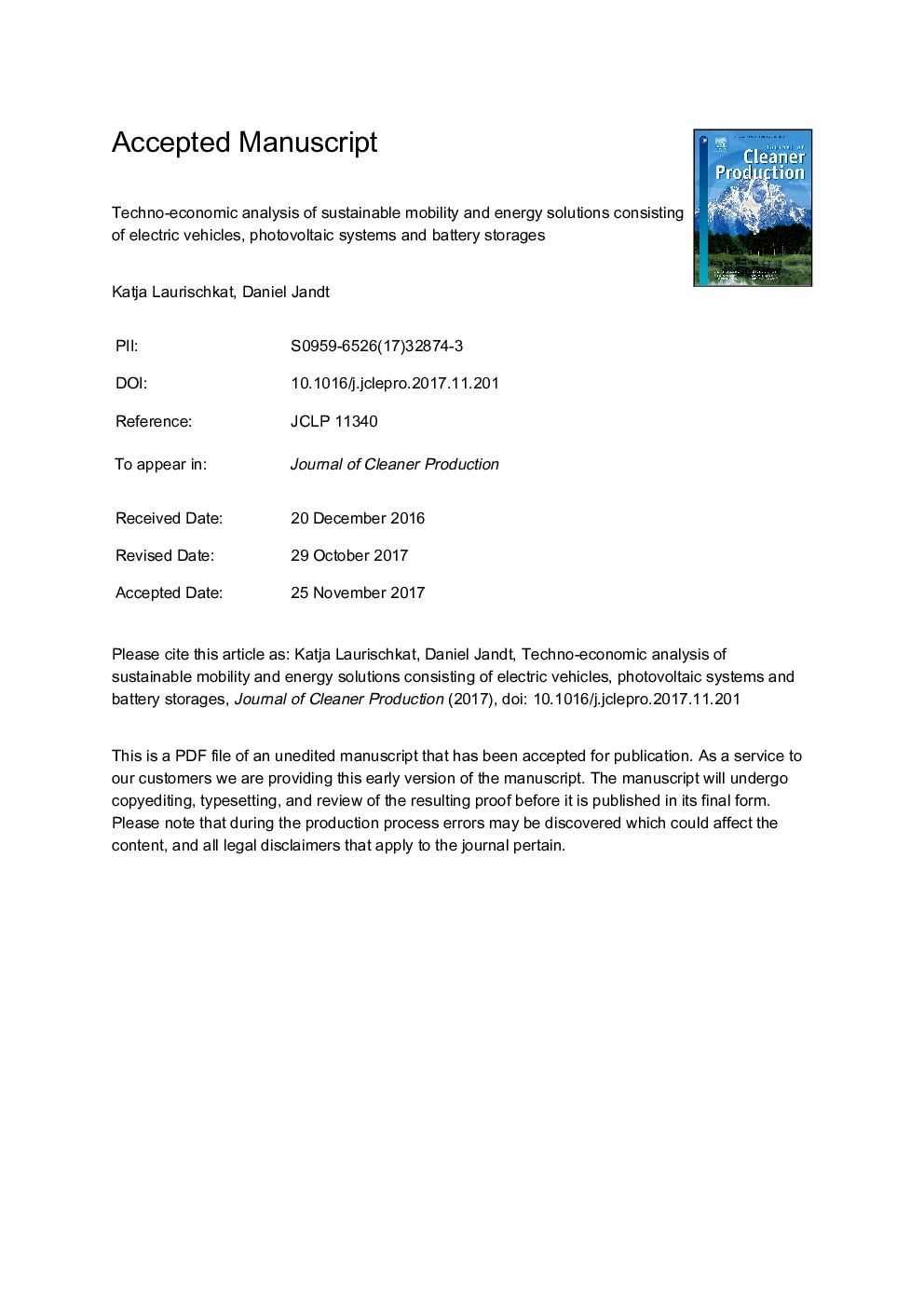| کد مقاله | کد نشریه | سال انتشار | مقاله انگلیسی | نسخه تمام متن |
|---|---|---|---|---|
| 8098289 | 1522074 | 2018 | 36 صفحه PDF | دانلود رایگان |
عنوان انگلیسی مقاله ISI
Techno-economic analysis of sustainable mobility and energy solutions consisting of electric vehicles, photovoltaic systems and battery storages
ترجمه فارسی عنوان
تجزیه و تحلیل تکنولوژیکی تحرک پایدار و راه حل های انرژی شامل وسایل الکتریکی، سیستم های فتوولتائیک و ذخیره سازی باتری
دانلود مقاله + سفارش ترجمه
دانلود مقاله ISI انگلیسی
رایگان برای ایرانیان
کلمات کلیدی
دینامیک سیستم، تحرک الکتریکی، انرژی های تجدیدپذیر، نفوذ نوآوری، مدل های کسب و کار،
ترجمه چکیده
وسایل نقلیه الکتریکی، سیستم های فتوولتائیک و ذخیره سازی باتری اجزای امیدوار کننده از تحرک پایدار و راه حل های انرژی برای خانوارهای خصوصی است. انتشار سریع این تکنولوژی ها نیاز به رقابت هزینه های خود را در مقابل تکنولوژی های معمولی مانند موتورهای احتراق داخلی و نیروگاه های فسیلی دارد. دینامیک سیستم پیشبینی توسعه مدلهای پیچیده کسب و کار برای راه حلهای پایدار را پیشبینی کرده است، زیرا مدلهای ذهنی یک کسب و کار صریح و بنابراین بهتر بر اساس مطالعات شبیهسازی قابل ارزیابی است. در حالی که دنبال هدف اصلی تضمین مزیت هزینه راه حل های پایدار نسبت به موارد متعارف است، سه مسئله حیاتی مورد توجه قرار می گیرند: اول، مزیت اقتصادی بستگی به پروفایل های رانندگی خاص و بار پروفایل خانوارها دارد، بنابراین توجه متفاوتی از بازار تودهای برای شناسایی مشتریان هدف مناسب برای راه حل های پایدار مورد نیاز است. دوم، مزایای هزینه تحت تأثیر بی ثباتی عوامل محیطی مانند قیمت برق، درآمد خوراک و قیمت سوخت قرار می گیرد. بنابراین، یک دیدگاه منظم از رقابت هزینه های راه حل های پایدار باید برای انجام یک کسب و کار قابل اجرا انجام شود. سوم، همکاری های فن آوری بین وسایل نقلیه الکتریکی، سیستم های فتوولتائیک و ذخیره سازی باتری به مشتریان اجازه می دهد که مستقل از قیمت برق باشند. از این رو، طراحی فنی محتاطانه از راه حل های پایدار ضروری است اگر مزایای اقتصادی برای مشتریان به طور کامل استفاده شود. براساس سیستم دینامیک، یک مدل جدید تکنولوژیکی اقتصادی برای تحرک و راه حل های انرژی، ترکیبات تکنولوژیکی بین سه جزء و هزینه های حاصل از تحرک و انرژی را نشان می دهد. از طریق تغییرات پارامتر، کاربر مدل می تواند نیازهای مشتری، عوامل محیطی و گزینه های طراحی فنی را تغییر دهد تا بازخورد فوری در مورد تغییر هزینه ها به دست آورد. شبیه سازی نمونه ای از جمله پروفایل های مشتری ایده آل و طرح های راه حل در بازار آلمان نشان می دهد که سهم قابل اجرا از انرژی فتوولتائیک در میان جریان رانندگی مزایای اقتصادی قوی علاوه بر محیط زیست دارد. این مدل با یک شرکت کمپانی آلمانی تأیید شده و به عنوان پایه علمی برای توسعه کسب و کار و برنامه های بازاریابی آینده آن عمل می کند.
موضوعات مرتبط
مهندسی و علوم پایه
مهندسی انرژی
انرژی های تجدید پذیر، توسعه پایدار و محیط زیست
چکیده انگلیسی
Electric vehicles, photovoltaic systems and battery storages are promising components of sustainable mobility and energy solutions for private households. A fast marked diffusion of these technologies requires their cost competitiveness against conventional technologies such as internal combustion engine vehicles and fossil-fired power plants. System Dynamics is hypothesized to advance the development of sophisticated business models for sustainable solutions as it makes mental models of a business explicit and thus better assessable on the basis of simulation studies. While pursuing the main aim of ensuring the cost advantage of sustainable solutions over conventional ones, three crucial issues are addressed: First, the economic benefit depends on the customer specific driving profiles and load profiles of the households, so a differentiated consideration of the mass market is needed to identify suitable target customers for sustainable solutions. Second, the cost advantage is affected by the volatility of environmental factors such as electricity prices, feed-in remunerations and fuel prices. Therefore, a regular view of the cost competitiveness of sustainable solutions has to be conducted in order to run a viable business. Third, the technological synergies between electric vehicles, photovoltaic systems and battery storages allow customers to be more independent from electricity prices. Hence, a prudent technical design of sustainable solutions is essential if the economic benefits for the customers are to be fully leveraged. Based on System Dynamics, a newly developed techno-economic model of mobility and energy solutions depicts the technological synergies between the three components and the resulting costs for mobility and energy. Through parameter variations, the model user is able to modify the customer needs, the environmental factors and the technical design options in order to gain an immediate feedback concerning the change in costs. Exemplary simulation runs including ideal-typical customer profiles and solution designs within the German market demonstrate that the realizable share of photovoltaic energy among the driving current holds strong economic benefits besides the ecological ones. The model is validated with a German utility company and serves as a scientific basis for their business development and their future marketing programs.
ناشر
Database: Elsevier - ScienceDirect (ساینس دایرکت)
Journal: Journal of Cleaner Production - Volume 179, 1 April 2018, Pages 642-661
Journal: Journal of Cleaner Production - Volume 179, 1 April 2018, Pages 642-661
نویسندگان
Katja Laurischkat, Daniel Jandt,
